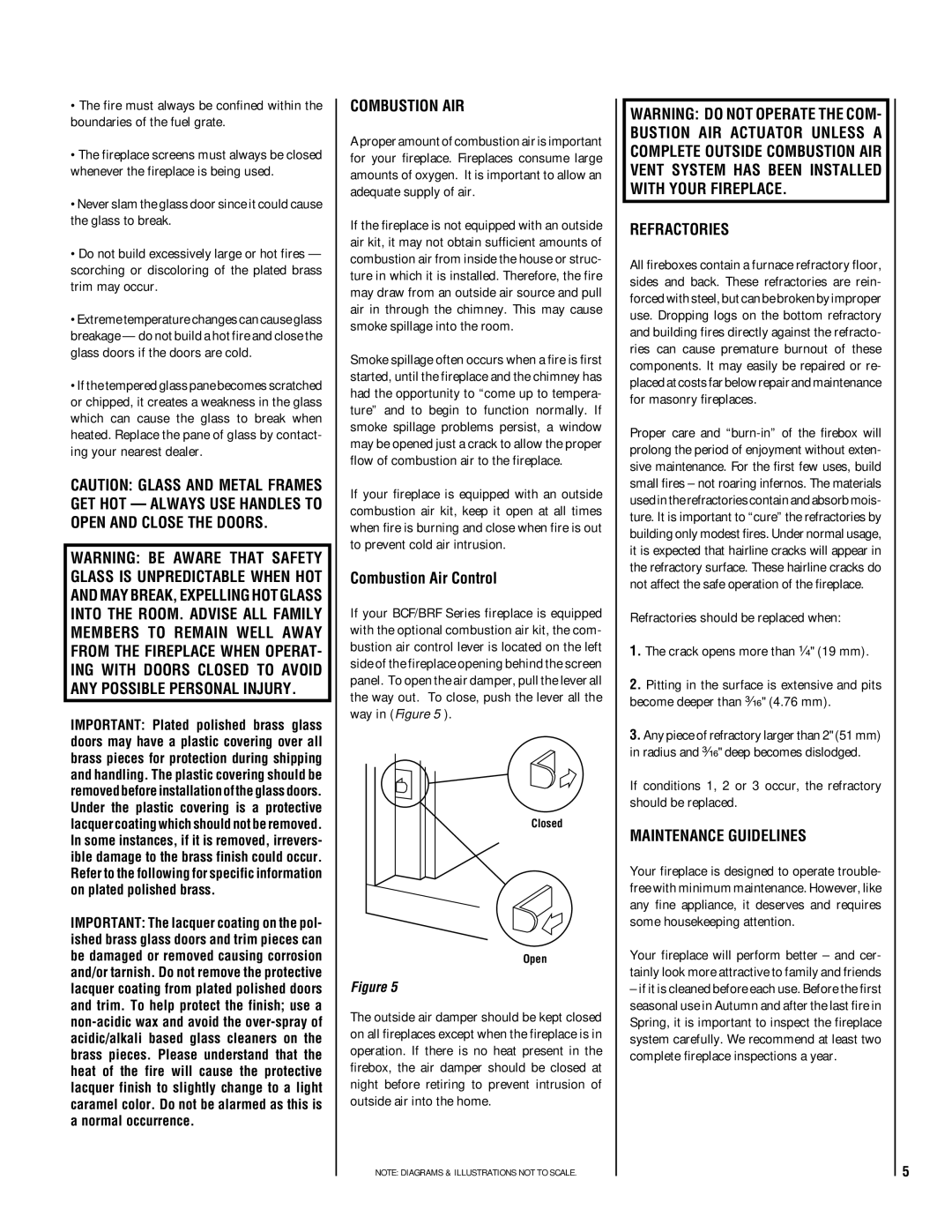
•The fire must always be confined within the boundaries of the fuel grate.
•The fireplace screens must always be closed whenever the fireplace is being used.
•Never slam the glass door since it could cause the glass to break.
•Do not build excessively large or hot fires — scorching or discoloring of the plated brass trim may occur.
•Extreme temperature changes can cause glass breakage — do not build a hot fire and close the glass doors if the doors are cold.
•If the tempered glass pane becomes scratched or chipped, it creates a weakness in the glass which can cause the glass to break when heated. Replace the pane of glass by contact- ing your nearest dealer.
CAUTION: GLASS AND METAL FRAMES GET HOT — ALWAYS USE HANDLES TO OPEN AND CLOSE THE DOORS.
WARNING: BE AWARE THAT SAFETY GLASS IS UNPREDICTABLE WHEN HOT AND MAY BREAK, EXPELLING HOT GLASS INTO THE ROOM. ADVISE ALL FAMILY MEMBERS TO REMAIN WELL AWAY FROM THE FIREPLACE WHEN OPERAT- ING WITH DOORS CLOSED TO AVOID ANY POSSIBLE PERSONAL INJURY.
IMPORTANT: Plated polished brass glass doors may have a plastic covering over all brass pieces for protection during shipping and handling. The plastic covering should be removed before installation of the glass doors. Under the plastic covering is a protective lacquer coating which should not be removed. In some instances, if it is removed, irrevers- ible damage to the brass finish could occur. Refer to the following for specific information on plated polished brass.
IMPORTANT: The lacquer coating on the pol- ished brass glass doors and trim pieces can be damaged or removed causing corrosion and/or tarnish. Do not remove the protective lacquer coating from plated polished doors and trim. To help protect the finish; use a
COMBUSTION AIR
A proper amount of combustion air is important for your fireplace. Fireplaces consume large amounts of oxygen. It is important to allow an adequate supply of air.
If the fireplace is not equipped with an outside air kit, it may not obtain sufficient amounts of combustion air from inside the house or struc- ture in which it is installed. Therefore, the fire may draw from an outside air source and pull air in through the chimney. This may cause smoke spillage into the room.
Smoke spillage often occurs when a fire is first started, until the fireplace and the chimney has had the opportunity to “come up to tempera- ture” and to begin to function normally. If smoke spillage problems persist, a window may be opened just a crack to allow the proper flow of combustion air to the fireplace.
If your fireplace is equipped with an outside combustion air kit, keep it open at all times when fire is burning and close when fire is out to prevent cold air intrusion.
Combustion Air Control
If your BCF/BRF Series fireplace is equipped with the optional combustion air kit, the com- bustion air control lever is located on the left side of the fireplace opening behind the screen panel. To open the air damper, pull the lever all the way out. To close, push the lever all the way in (Figure 5 ).
Closed
Open
Figure 5
The outside air damper should be kept closed on all fireplaces except when the fireplace is in operation. If there is no heat present in the firebox, the air damper should be closed at night before retiring to prevent intrusion of outside air into the home.
NOTE: DIAGRAMS & ILLUSTRATIONS NOT TO SCALE.
WARNING: DO NOT OPERATE THE COM- BUSTION AIR ACTUATOR UNLESS A COMPLETE OUTSIDE COMBUSTION AIR VENT SYSTEM HAS BEEN INSTALLED WITH YOUR FIREPLACE.
REFRACTORIES
All fireboxes contain a furnace refractory floor, sides and back. These refractories are rein- forced with steel, but can be broken by improper use. Dropping logs on the bottom refractory and building fires directly against the refracto- ries can cause premature burnout of these components. It may easily be repaired or re- placed at costs far below repair and maintenance for masonry fireplaces.
Proper care and
Refractories should be replaced when:
1.The crack opens more than ¹⁄₄" (19 mm).
2.Pitting in the surface is extensive and pits become deeper than ³⁄₁₆" (4.76 mm).
3.Any piece of refractory larger than 2" (51 mm) in radius and ³⁄₁₆" deep becomes dislodged.
If conditions 1, 2 or 3 occur, the refractory should be replaced.
MAINTENANCE GUIDELINES
Your fireplace is designed to operate trouble- free with minimum maintenance. However, like any fine appliance, it deserves and requires some housekeeping attention.
Your fireplace will perform better – and cer- tainly look more attractive to family and friends
–if it is cleaned before each use. Before the first seasonal use in Autumn and after the last fire in Spring, it is important to inspect the fireplace system carefully. We recommend at least two complete fireplace inspections a year.
5
